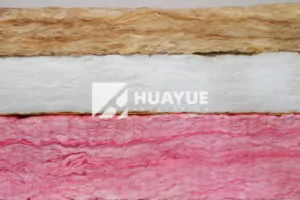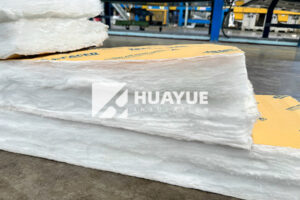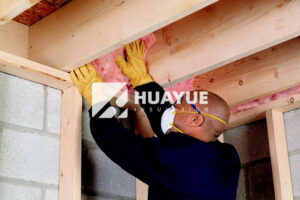How Long Does Fiberglass Insulation Last in an Attic?
Wondering if the insulation in your attic is past its prime? It’s a common concern for homeowners looking at rising energy bills and questioning whether that old, dusty insulation is still doing its job.
When installed correctly and kept free from moisture and pests, fiberglass insulation can last 80 to 100 years in an attic. The material itself does not degrade, meaning it can effectively last for the entire lifespan of your home.
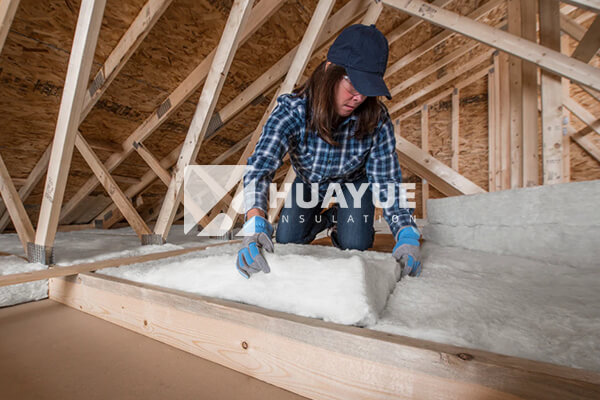
The durability of your insulation is a key factor in your home’s long-term energy efficiency. As a manufacturer and global supplier of insulation materials like glass wool since 1998, we at HUAYUE have a deep understanding of what makes these products last. The good news is that fiberglass is incredibly resilient. However, its impressive lifespan depends entirely on the conditions in your attic. Let’s explore when it needs attention and what can shorten its life.
How often should attic insulation be replaced?
Are you worried about a hidden expiration date on your insulation? It’s a source of anxiety for many homeowners who don’t want to face the cost and hassle of a replacement project unexpectedly.
Attic insulation does not have a set replacement schedule. You should only replace it if it has been significantly damaged by water from a leak, infested by pests, or contaminated with mold. Otherwise, it’s often better to add new insulation on top of the old.
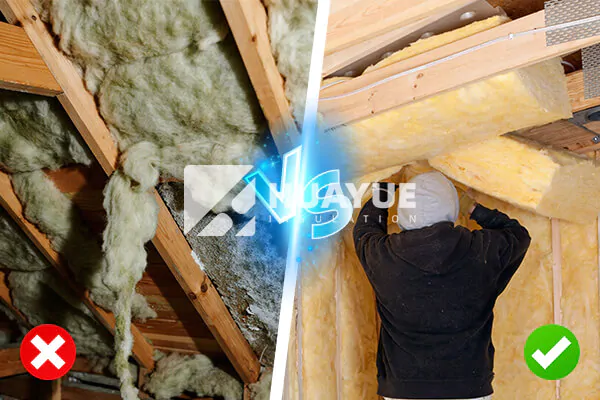
Deeper Dive into Replacement Cycles
In my 30+ years in the insulation industry, I’ve seen countless attics. The idea that insulation needs to be replaced every 15-20 years is a common misconception, often perpetuated by those looking to sell a service. The reality is far more straightforward. Fiberglass is made of glass—an inorganic material that doesn’t rot or decompose. Its insulating power comes from the air pockets trapped between its fibers. As long as those air pockets are intact and the material is clean and dry, it will continue to perform its job effectively, decade after decade.
You should only plan for a full replacement under specific circumstances:
- Water Damage: If you’ve had a roof leak, the water will compress the fiberglass and mat it down, destroying its "loft" and R-value. Wet insulation is also a breeding ground for mold and mildew, which can damage your home’s structure and air quality. In this case, the damaged sections must be removed.
- Pest Infestation: Rodents, birds, or insects can make nests in insulation, fouling it with droppings and creating tunnels that ruin its thermal barrier. This contaminated material poses a health hazard and should be professionally removed.
- Major Renovations: If you are doing significant work that requires accessing the attic ceiling, such as rewiring or remodeling, it may be easier to remove the old insulation to do the work properly.
Barring these issues, your insulation is not on a clock.
Should I remove old attic insulation before adding new?
Planning to boost your attic’s R-value but unsure what to do with the old stuff? The thought of removing it all seems like a massive, messy, and expensive job.
In most cases, you should not remove old attic insulation. If the existing insulation is dry and in good condition, you can simply add new unfaced insulation directly on top of it. This is not only cost-effective but also adds to the total R-value of your attic.

Deeper Dive into Topping Up
Topping up is the standard best practice in the insulation industry for a reason. R-value is cumulative. The thermal resistance of your old insulation, even if it’s less than current standards, still contributes to your home’s overall energy efficiency. Removing it would be like throwing away a perfectly good sweater just to put on a new coat. When you lay new insulation over the old, you are simply adding to the total R-value. For example, if your old insulation provides R-19 and you add a new layer of R-30, your attic will now have a total R-value of R-49.
The process is straightforward. New unfaced batts or rolls can be laid perpendicular to the joists, covering both the old insulation and the tops of the joists to create a continuous thermal blanket. Alternatively, a professional can blow in a fresh layer of loose-fill fiberglass right over the top. The only time you absolutely must remove the old insulation first is if it is wet, moldy, or heavily contaminated by pests, as discussed earlier. Covering up these problems will only make them worse. But for the vast majority of homes, topping up is the smarter, faster, and more economical choice.
Is it worth replacing old fiberglass insulation?
Is your older home not as comfortable as you’d like? You might be looking at your thin layer of attic insulation and wondering if a full replacement is a worthwhile investment.
It is worth replacing old fiberglass insulation only if it’s damaged. If it’s just old but in good shape, it’s far more worthwhile to add new insulation on top. The return on investment for topping up insulation is one of the highest of any home improvement project.

Deeper Dive into the Value Proposition
The U.S. Department of Energy states that improving attic insulation is one of the most cost-effective ways to make your home more comfortable and energy-efficient. You can often save between 10% and 50% on your energy bills. Let’s analyze the "worth." A full removal and replacement project can be expensive, potentially costing several thousand dollars. You would only see a return on that investment if the original insulation was actively causing problems (like mold) or was so sparse as to be effectively useless.
The real value lies in bringing your attic up to modern standards. Many older homes have as little as 3-6 inches of insulation (around R-9 to R-19). Current recommendations for most parts of the country are R-38 to R-60. The project of adding R-30 of new insulation over your existing R-19 will have a much faster payback period than a full replacement. You get the immediate benefits of a more comfortable home—less drafty in winter, cooler in summer—and significant, noticeable savings on your monthly heating and cooling bills. In this context, it is absolutely worth upgrading your old insulation.
What is the biggest problem with fiberglass insulation?
Worried there’s a hidden catch with such a common material? When choosing insulation, it’s just as important to understand its weaknesses as it is to know its strengths.
The biggest problem with fiberglass insulation is its vulnerability to moisture. When fiberglass gets wet, it compresses and loses its loft. This permanently destroys its R-value, as the trapped air pockets—which do the actual insulating—are eliminated.
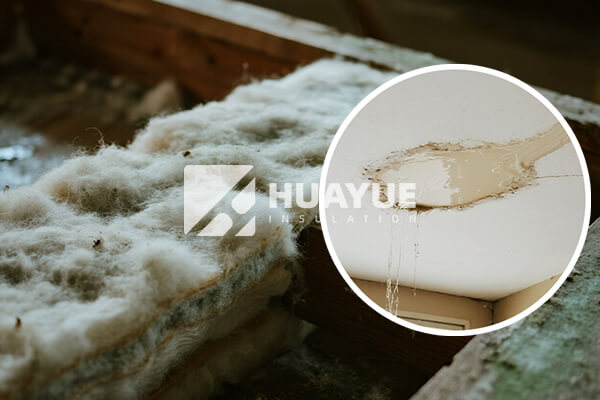
Deeper Dive into Moisture-Related Issues
While fiberglass itself is made of glass and therefore waterproof, the structure of the insulation acts like a sponge. The billions of tiny air pockets that make it such a great insulator can become filled with water from a roof leak or high humidity and condensation. When this happens, a few negative things occur. First, water is a good conductor of heat, so the insulation’s thermal resistance plummets. Second, the weight of the water compresses the fibers, and even after it dries, the fiberglass may not fluff back up to its original thickness. This loss of "loft" is a permanent loss of R-value.
Finally, and perhaps most critically, the trapped moisture creates a perfect environment for mold and mildew to grow on the surrounding organic materials like wood joists and drywall paper. The insulation holds the moisture against these surfaces, which can lead to structural rot and poor indoor air quality. This is why addressing roof leaks immediately is so critical. While other issues like improper installation or pest damage can be problematic, moisture is the number one enemy that can single-handedly ruin an entire attic’s worth of insulation.
How do I know if my attic insulation needs to be replaced?
Not sure what you’re looking for when you peek into your attic? It can be hard for an untrained eye to tell the difference between effective insulation and insulation that’s failing.
You’ll know your attic insulation needs to be replaced if you see visible signs of widespread water damage (stains, matting), mold growth, or pest infestation (droppings, nests). Other key indicators include inconsistent indoor temperatures and rising energy bills.
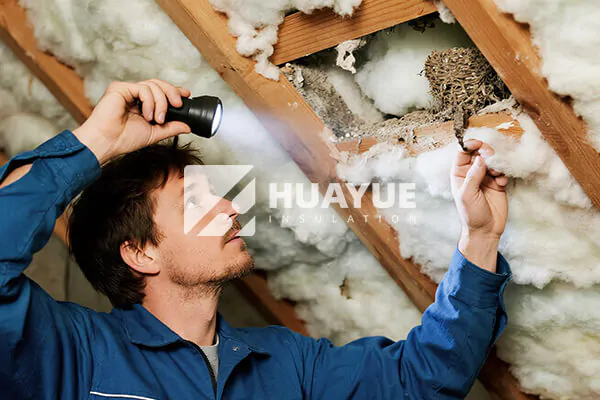
Deeper Dive into the Inspection Checklist
Performing a quick visual inspection can tell you almost everything you need to know. Grab a flashlight and look for these five key warning signs:
- Visible Water Stains: Look for dark stains on the insulation, the underside of the roof decking, or the wood joists. This is a clear sign of a past or present leak.
- Compacted or Matted Areas: Does the insulation look flat, clumpy, or uneven? Healthy insulation should be light and fluffy. Compacted spots, especially below leaks, have lost their R-value.
- Signs of Pests: Look for rodent droppings, chewed materials, tunnels through the insulation, or nesting areas. This indicates a contamination problem that compromises both health and thermal performance.
- Mold or Mildew: Search for any black, grey, or green splotches on the insulation or surrounding wood. A musty smell in the attic is another huge red flag for mold, even if you can’t see it.
- Insufficient Depth: Use a ruler. If your insulation level is below the top of your joists (typically 6-10 inches), you almost certainly don’t have enough to meet modern energy standards, even if it’s in good condition. While this doesn’t require replacement, it’s a clear sign you need to add more.
If you see any of the first four signs on a widespread scale, a full replacement is likely necessary. If you only see insufficient depth, you’re a perfect candidate for adding a new layer on top.
Conclusion
In summary, fiberglass insulation is a durable, long-lasting material for your attic that should not need replacement unless it’s been damaged. For most homes, the best path is simply adding more on top.
At HUAYUE, our expertise since 1998 has been in manufacturing world-class insulation solutions. We provide top-quality glass wool, rock wool, and more, offering customized wholesale options to partners in over 100 countries.
You may also be interested in:
Ready to Get Started?
Get in touch with our experts for personalized solutions tailored to your needs.
Get Free QuoteLatest Articles
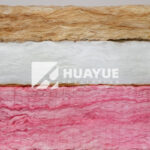
Eco Batt Insulation: What You Need to Know?
Dec 12, 2025
Let's Work Together
Ready to take your business to the next level? Get in touch with our team of experts and let's discuss how we can help you achieve your goals.
Get Free Solutions
